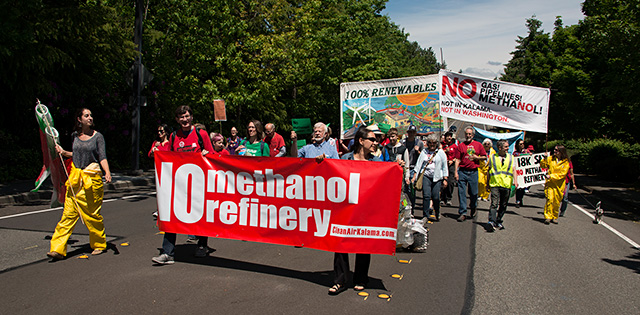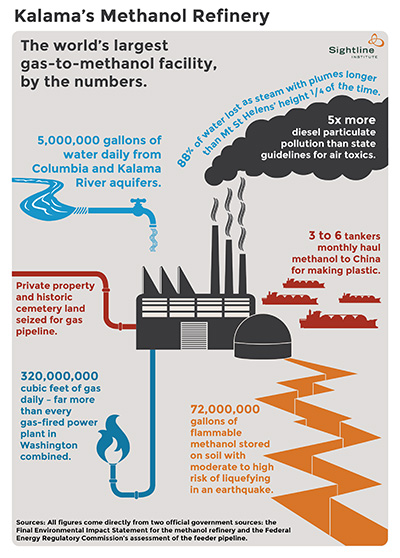
Climate activists have held the line against Shell’s Arctic drilling plans, shut down tar sands valves at refineries and waged wave after wave of actions against new fossil fuel proposals for coal export terminals and oil-by-rail refineries in the Pacific Northwest. Late last year, Portland moved to the forefront of opposition to coal, oil and gas exports when its city council voted unanimously to prohibit new fossil fuel infrastructure in the city. But opposing a proposal to build the world’s largest gas-to-methanol refinery on the banks of the Columbia River in Washington State may be the most challenging fossil fuel fight that activists have waged to date. A subsidiary of the Chinese government, Northwest Innovation Work (NWIW) has proposed to harness the region’s vast natural resources using fracked gas piped in from British Columbia and convert it to methanol, a volatile, flammable liquid alcohol. Methanol was previously distilled from wood but it is now chiefly made by oxidizing methane, a heat-trapping gas that is fracked out of natural gas.
Plans for a Methanol Refinery in the Port Town of Kalama
In this case, the facility would ship tankers full of methanol to China to be used in making plastics. Five hundred thousand gallons of water would be piped from local aquifers and mixed with 320 million cubic feet of gas — far more than used by all gas-fired power plants in Washington combined — to make 72 million gallons of flammable methanol, according to a study by Sightline, a regional think tank. A graphic accounting of the proposed methanol refinery for the small port town of Kalama, Washington, in the report looks like this:
 (Graphic: Sightline Institute)“It’s an enormous petrochemical project way out of scale of anything the Pacific Northwest has considered in the past,” said Eric de Place, an energy policy analyst with the Sightline Institute. “It should raise deep questions about whether we want to convert the lower Columbia River or the Northwest into a big manufacturing center for petrochemicals and go down the same road that we see in Gulf Coast states like Louisiana and Texas.” NWIW promotional literature says the company is “building the bridge to a stronger regional economy and cleaner global environment” and “working to reduce coal consumption in order to eliminate chronic air pollution and address concerns about long-term climate change.” Plans for the methanol refinery emerged after Gov. Jay Inslee hosted a trade delegation from China.
(Graphic: Sightline Institute)“It’s an enormous petrochemical project way out of scale of anything the Pacific Northwest has considered in the past,” said Eric de Place, an energy policy analyst with the Sightline Institute. “It should raise deep questions about whether we want to convert the lower Columbia River or the Northwest into a big manufacturing center for petrochemicals and go down the same road that we see in Gulf Coast states like Louisiana and Texas.” NWIW promotional literature says the company is “building the bridge to a stronger regional economy and cleaner global environment” and “working to reduce coal consumption in order to eliminate chronic air pollution and address concerns about long-term climate change.” Plans for the methanol refinery emerged after Gov. Jay Inslee hosted a trade delegation from China.
Jasmine Zimmer-Stucky is a member of Columbia Riverkeeper, a national alliance whose mission includes keeping the Columbia River healthy for the region’s iconic salmon and steelhead. Zimmer-Stucky says NWIW came to Kalama and formed an “astroturf” group called Citizens for a Green Economy in an attempt to brand the refinery as a clean energy project. The group showed up at public hearings wearing green shirts with planets and trees on them “and talked about how much they cared for our climate and why building the world’s largest methanol refinery was a good move,” she said. Local 48 of the International Brotherhood of Electrical Workers (IBEW) strengthened Citizens for a Green Economy by becoming a member of it.
A separate proposal to build the methanol refinery in the port city of Tacoma, south of Seattle, was defeated last year after fierce public opposition. After the defeat, Zimmer-Stucky said, the governor toned down his support.
But the Port of Kalama and Kalama County are firmly behind the proposal for a refinery in their own region. In a town where jobs are scarce, local officials approved permits with the promise of 1,000 construction jobs and 200 full-time jobs. The county was also responsible for issuing an Environmental Impact Statement (EIS). Normally, the Washington State Department of Ecology takes the lead in issuing an EIS, but the agency was already working on three other EIS processes in southwest Washington, according to spokesperson Curt Hart, and didn’t have additional resources to manage another. As a result, the county issued both the initial EIS and the final EIS, after the department ordered a review.
“Shut It Down”: Resistance Mounts Against Refinery
At a rally outside a Washington State Department of Ecology field office last week, opponents of the methanol refinery — including fishers, faith leaders, doctors with Washington Physicians for Social Responsibility, 350 Seattle, the Sierra Club and others — chanted “Shut it down. No methane. No pipelines. We are on the front lines.” Some wore yellow hazmat suits and carried graphic banners of wind turbines and solar panels calling for 100 percent renewables.
“Fracked gas is just another dirty fossil fuel,” said the Sierra Club’s Cecile Gernez, conservation organizer for the Washington State chapter. She encourages the public to reject the term “natural gas” and instead call it “fracked gas” to acknowledge that its extraction process involves injecting large quantities of ground water and chemicals into subterranean rock. The environmental consequences of this process include contaminated ground water and air pollution.
While carbon dioxide is typically painted as the “bad boy” of greenhouse gases, methane — the main ingredient in gas — is roughly 30 times more potent as a heat-trapping gas. “It’s cheap and there’s not that much public sentiment against it yet because of a greenwashing campaign that touts it as a clean alternative to coal,” Gernez said. “Unfortunately, a lot of our elected officials believe it.” The Washington State Department of Ecology received 19,000 comments opposing the methanol refinery — despite the fact that the Port of Kalama has a population of only 2,000 — on everything from climate impacts, to water use and gas consumption, public safety from pipeline leaks, and risks to coastal and local waters.
“At some level, the regulatory and permitting agencies are aware of these issues,” said Eric de Place from the Sightline Institute. At the same time, he said, he doesn’t think the agencies are taking the time to assess the aggregate effects that communities will face if a giant petrochemical refinery is added to an area that already has a huge coal project or oil refinery. The agencies are not looking at what might happen in a climate-constrained world, he suggests, if there’s less available water with warmer winters, or less snow pack, or when too many ships are trying to navigate the treacherous Columbia Bar. Still, Northwest communities — and at times, state governments — are rejecting applications for shipping out coal, crude oil, methane and all forms of unrefined fossil fuels. The lands commissioner for Washington State rejected an application for a controversial coal export terminal in southwest Washington early this year. Whatcom County, on the state’s northwest coast, adopted an ordinance last fall preventing county agencies from accepting permits for new or expanded coal, oil, methane and all forms of “unrefined fossil fuels.” But this week Washington state regulators approved two permits for what could become the world’s largest methanol refinery. The Washington State Department of Ecology approved a shoreline conditional use permit and water quality certification for an extended pipeline.
Columbia Riverkeeper and other public interest organizations say they will appeal the shoreline permit and what they call “the methanol refinery’s woefully inadequate Environmental Impact Statement” to the Washington Shorelines Hearing Board. In a press statement, they said: “from ocean acidification to rising sea levels to forest fires, Washington state is experiencing the catastrophic impacts of climate change. Approving the world’s largest methanol refinery flies in the face of Governor Inslee’s commitment to take action on climate change.”
The Sierra Club also noted that when Ecology made permitting decisions on coal export projects, “both upstream and downstream climate impacts were considered. No such consideration was made for this project.”
Throughout the process, Governor Inslee’s office has “indicated an interest in the company’s proposal and appreciates their work with the local community.” In an email, a representative of the governor’s office added that Inslee is “in favor of electrifying as much of our energy system as possible and taking advantage of the fact that we have one of the cleanest electrical grids in the nation.” The email went on to say that “there is no single technology or strategy that will transition us immediately to a clean energy future.” Among policymakers, the idea that natural gas is a “bridge fuel” is still widely accepted. The Obama administration aggressively embraced the replacement of coal with gas as a key part of meeting its 2030 climate targets. What is less widely discussed is that natural gas is predominantly composed of methane. While methane has a much more powerful warming effect on the atmosphere than carbon dioxide, there is less of it, and the gas is relatively short-lived. According to new research by Purdue University and the Environmental Defense Fund (EDF) cited in a report in the UK Independent earlier this year, mass for mass, methane still has 28 to 34 times the greenhouse effect of carbon dioxide over 100 years. One of the researchers, Professor Paul Shepson of Purdue, said methane is “a better fuel all around — as long as you don’t spill it.” But a little bit of leakage has the potential to dramatically accelerate climate change.
Carbon dioxide, on the other hand, has a much longer atmospheric lifetime. About half of the carbon dioxide emitted today will be around in 100 years. So, the question of whether natural gas is a “bridge fuel” depends in part on whether you care about the short or long term. “The idea that natural gas is a ‘bridge fuel’ to get us off coal is out of a 1992 textbook,” Zimmer-Stucky said. “It just doesn’t apply to the 21st century, especially when 70 percent of Washington’s gas comes from fracking. With fracking polluting our water and natural landscape, there’s no way we can play the coal versus gas game. Both need to be phased out. Immediately.”
Join us in defending the truth before it’s too late
The future of independent journalism is uncertain, and the consequences of losing it are too grave to ignore. To ensure Truthout remains safe, strong, and free, we need to raise $44,000 in the next 6 days. Every dollar raised goes directly toward the costs of producing news you can trust.
Please give what you can — because by supporting us with a tax-deductible donation, you’re not just preserving a source of news, you’re helping to safeguard what’s left of our democracy.